Even though Studebaker’s finances were growing thin by the 1960s, they still developed some great cars before ceasing operations in 1966. The Avanti and the Gran Turismo are two examples. Add to this list would be the supercharged Lark Daytona. With a 289 V8 that was capable of one horsepower per cubic inch, it transformed the Lark compact into a potent performer. This nicely restored example is a rare find today and has been with the same owner for the past 15 years. Located in Collierville, Tennessee, it’s available here on eBay where the Stude has been listed by a dealer and the bidding has reached $10,100. But the reserve is likely to be quite a bit higher.
The Lark debuted in 1959 and gave Studebaker a much-needed shot in the arm, although it was short-lived when Ford, Chrysler, and the others entered the compact market in 1960. The Daytona would join the party for 1962 as the more upscale, sporty version of the Lark. We understand that only 2,157 R2s Paxton superchargers were installed in Studebaker products that year. 352 were Lark Daytona’s and – of those – just 110 were paired with a 4-speed manual transmission.
The seller’s ’63 Daytona R2 has been restored, garage-kept, and documented by its owner who kept the car in Mississippi. We’re told that virtually everything has been rebuilt or replaced from stem to stern. The automobile has only covered 62,582 miles, although we don’t know how many of those are since the restoration. The SN60 supercharger was included in the refreshing process along with the V8 engine itself as well as suspension and chassis components.
We suspect the repaint in Regal Red may be older than the rest of the work as there seem to be a few scratches and scrapes in a couple of places, but it could be the images. But it’s a sharp-looking automobile, with great chrome and trim. The red and white interior could be even nicer than the exterior with a passenger cabin that is quite inviting, especially those bucket seats. The Daytona sports a period-correct tachometer and a Hurst shifter for the Borg-Warner T-10 4-speed. Aftermarket Rev wheels and radial tires are on each point of the car rather than steel wheels with bias-ply rubber.
It’s a shame that cars like the Avanti and Daytona were too little too late in the Studebaker timeline to save the company. U.S. production ceased at the end of 1963 in South Bend, Indiana and remaining operations shifted to Hamilton, Ontario where they would solider on into 1966. Like American Motors, Studebaker was an underdog automaker that was one of the last independent car companies on U.S. soil. This R2 would be a great addition to anyone’s Studebaker collection, as long as the price is right.





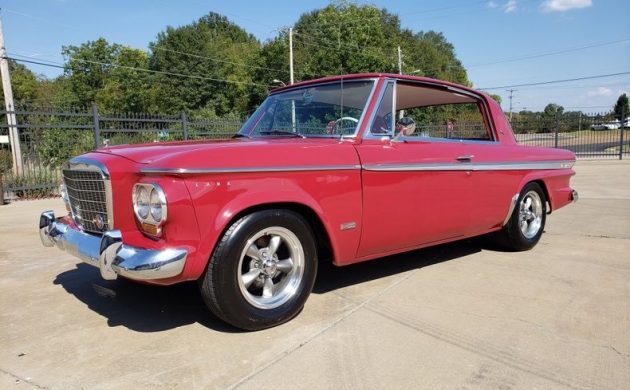
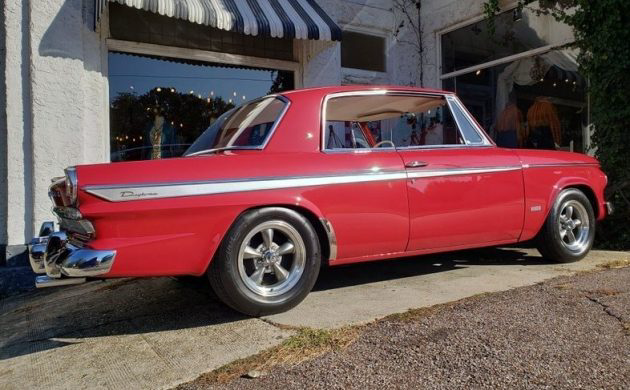

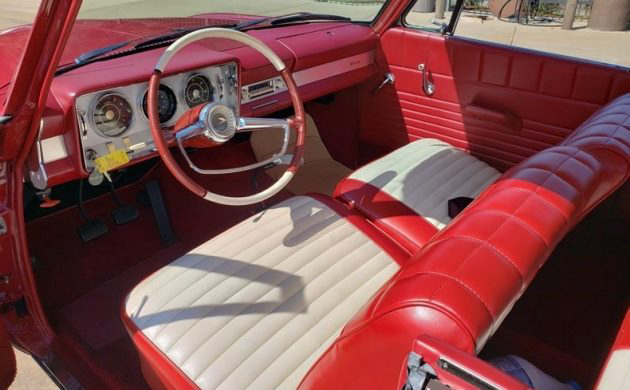
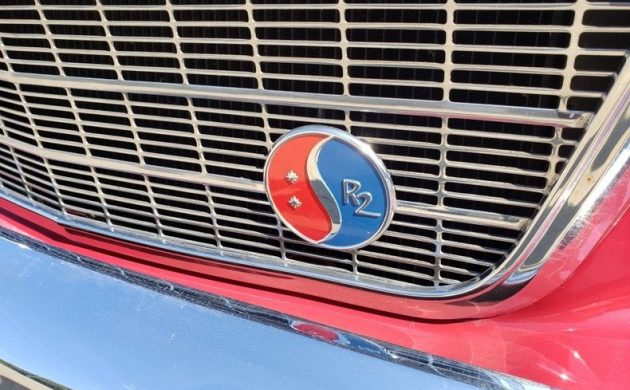
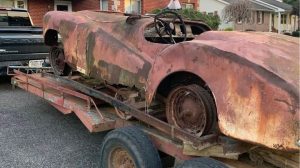
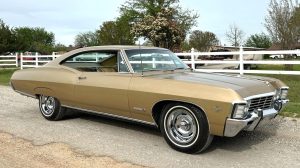
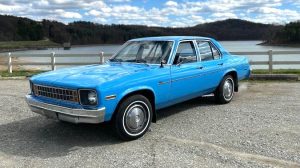



One of these is a vintage racer in England.Was run at Goodwood.
Wow! That is some presentation on that rare lark. My ’61 year-old eyes are not what they used to be so just asking if the driver’s door gap, door body line and door chrome to quarter chrome alignment look a off to anyone else? It’s interesting how even metal gauge dials like the two outer dash gauges here have faded together over time and the NOS (I presume) sourced tach is so obvious.
Good eyes. The trim on the driver’s door is slightly misaligned. The gaps for both doors do appear to be inconsistent. Those are long doors so some gap issues may be due to hinge pin wear.
Looks like the gap and alignment are worse on the passenger side, although this might just be from the glare of the sun in the photo.
Not an NOS tach, cheapo Sunpro aftermarket piece.
egads— You may be wrong here. Lark R2’s used the Studebaker GT Hawk tachometer which looks different from the speedo. Look at some other pictures online. It’s a poor picture though, so it’s a little hard to tell.
Says Sunpro in BIG red letters on the face>
Ugh, again with the supercharger. 1st, always liked the Lark, it’s as if the folks from S.Bend had a kindred connection with us from Wis. We both fought hard to stay with the Big 3. I felt Studebaker was superior to Rambler. They had options that took the others years to add, some never did. 2nd, the supercharger. These cars were so unpopular, nobody I ever saw had one. Studebakers were always derelict, back row, smoking, rusty hulks, on their last legs ( Rambler wasn’t far behind) and the only ones that were saved, were the supercharged ones, or supercharger added later on a restoration to attract buyers. Believe me, few would want a stock Studebaker today, it’s too unknown to too many people. I read somewhere, it was the name. like “Oldsmobile”, being “old”, didn’t help. This is a great find, not sure how the supercharger behaves in stop and go traffic, I’m sure it must “load up” the motor, I SAY, have a “dummy” supercharger, for effect, and more mild driving manners. Do you really need a supercharger today?
Cool find, and Wiiillllbur would be proud!
https://www.pinterest.com/pin/247557310748358191/
Howard— “few would want a stock Studebaker today”… really? The Studebaker Driver’s Club is one of the largest car clubs in the world, with over 12,000 members.
It’s great to hear, Kenny, but are any of the members under 50? 60? Car clubs have gone the way of common sense, and membership in all clubs is declining at an alarming rate. Actual hands on ( hey, it was okay to touch and sit in our Packard) meets are replaced by this machine, and Barn Finds has become the club. I know, it pains me too, along with about 50 other things in this modern society, but it’s here to stay. I bet 3 out of 4 folks at a baseball game today, couldn’t tell you what a Studebaker or a Packard was.
I have to agree with Howard A. I had my heart set on a deal to trade my 1974 MG for a 62 Studebaker sedan (being sold by a young fella who’d bought it an an estate sale and didn’t know much about them). It was a learning experience to watch his eyes open wide considering “gaining” a well-known British convertible and unloading his old, underpowered pedestrian sedan on an old man like me. In the end, other than perhaps a restored Transtar, Loewy coupe, or an Avanti I just couldn’t bring myself to trade my little go cart on a medium green Lark sedan with as much charisma as a loaf of bread.
My Brother Had a 1957 Golden Hawk Supercharged and never had a problem with it on road or traffic never loaded up. I knew about 3 other people that had hawks and no problems with super charger.
Studebaker needed replacement bean counters! For as many sharp cars as they produced over the years of their existence, they really should still be with us!
Never heard many complaints about Studebaker mechanicals, but lake effect snow off Lake Erie in northern Ohio, and road salt to combat it, ate these Studies up in four or five years. Can’t recall seeing the STUDEBAKER call outs on the valve covers like this car. Factory or aftermarket? Reminds me of the BUICK covers some nail heads had.
2002’s german copier? Some pic kinda indicate that?
There was one at the Crawford Museum in Cleveland, white with red interior I believe. Nice car that probably out ran most of the big three cars.
anyone notice the spacers in the front coil springs?
I lived in South Bend Indiana 1956 to ´57, boy what a loveley pkace it was – right out of the pages of Readers Digest magazine. As an immigrant kid, I thought for sure that everyone would be driving a Stude, after all, it was ¨their¨ car — wrong. In my neighborhood (up scale) there wasn´t even ONE gracing a drive way and my new found friends at John Adams High thought me odd for thinking how I did. My dear buddy Bob Cooper however drove one with which he delivered for his father´s Drug Store. I learned to love the USA back then – great people, great place to live. Todays Americans don´t have an idea what has been lost, it pains me to think about it. Hell, I even liked school!
Seems there’s no end to the cars people will destroy in the name of changing them into hot rods. Would love to find a nice one of these in stock.
Jim. Aftermarket wheels, tach and valve covers destroyed this car???? Explain please.
Its been proven that if it takes more than 10 minutes to replace all of the aftermarket parts with stock pieces the car has been ruined forever.
Steve R
These are really cool cars. The 65 Daytona if my favorite though. Here is a 63 R2 in a drag race with a Pontiac. It’s a fun watch. Also a tribute to an awesome drag racer.
https://youtu.be/rnq7uJcgJug
Studebaker built good cars until the mid ’50s. True, the Lark helped them but the first ones were turds, and that did NOT help. By the time they “fixed” it (like this one) it was too late. True, they had some beautiful designs as some of you have mentioned, but ancient, compromised mechanicals underneath except for the engines. They weren’t even CLOSE to AMC, Howard A! At that time AMC already had strong unitized bodies with a type of crumple zone (way ahead of other manufacturers), well-designed interiors, and some excellent to outstanding engines. What they did on a shoestring budget is amazing to this very day. Look at the AMC Spirit elsewhere in this article; Ill bet that guy surprises a lot of “kids” in their flatulent Hondas!
Sorry “history” books, John Delorean, et al BUT this was ahead of the GTO as the 1st production muscle car….
Sorry, Norm, the first production “muscle car” would have been the 1957 Rambler Rebel! This one did indeed beat DeLorean and the GTO as well the Fords.
Sorry John, but the 1956 Studebaker Golden Hawk beat your Rambler to the punch… fastest accelerating production car there was then. Giant Packard V8, available stick shift, tachometer and full gauges, 160 mph speedometer, and Positraction available late in the year. Easy 130+ MPH car. Faster than Corvette, T-bird, or Chrysler 300. I own one with Dealer-installed Dual-quads. It is a tire-fryer of the first order.
Agreed, Kenny, and I thought about that car before responding. It doesn’t qualify for the strict definition of a “muscle car” because it was a sport coupe/GT body. For this definition muscle cars were mid-sized family haulers into which a big V-8 was dropped, then enhanced with upgraded suspension and brakes. Otherwise, no argument, and enjoy that pretty car!